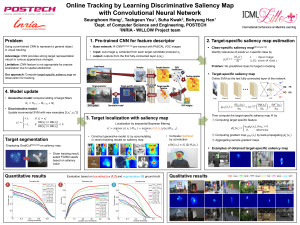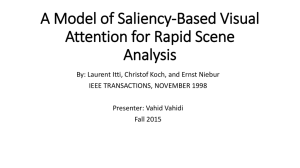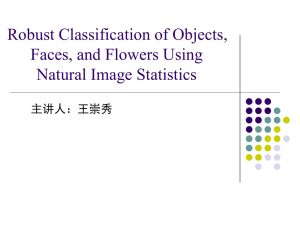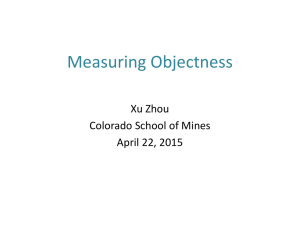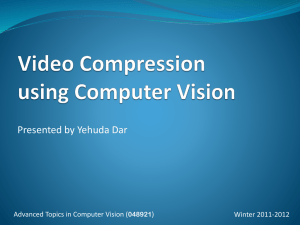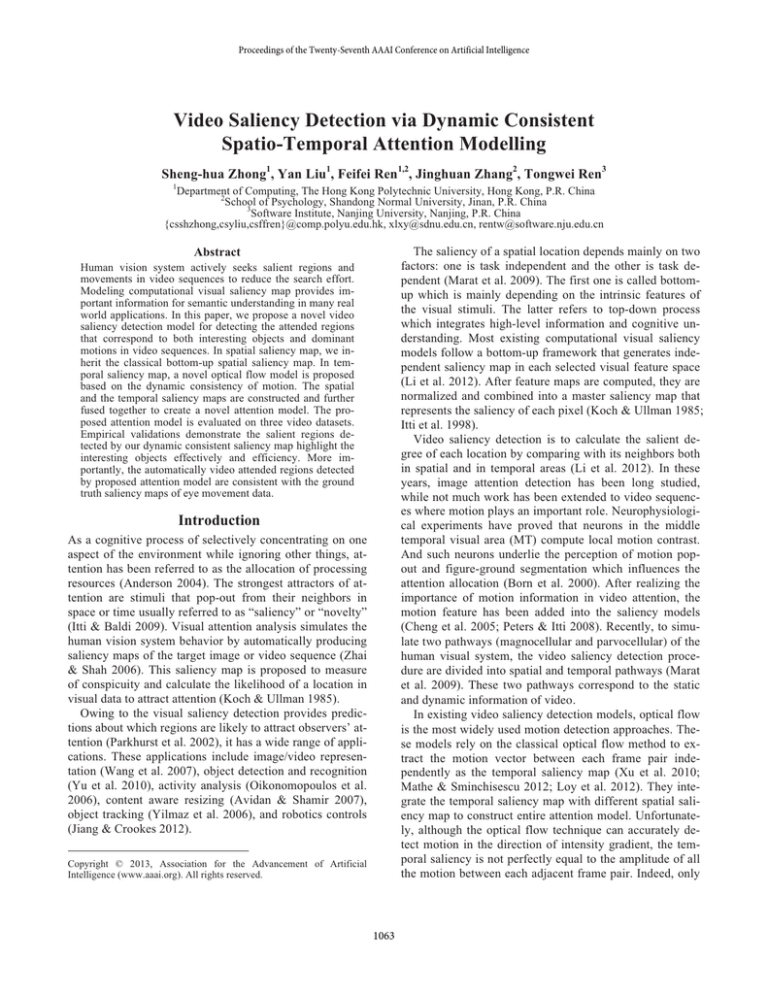
Proceedings of the Twenty-Seventh AAAI Conference on Artificial Intelligence
Video Saliency Detection via Dynamic Consistent
Spatio-Temporal Attention Modelling
Sheng-hua Zhong1, Yan Liu1, Feifei Ren1,2, Jinghuan Zhang2, Tongwei Ren3
1
Department of Computing, The Hong Kong Polytechnic University, Hong Kong, P.R. China
2
School of Psychology, Shandong Normal University, Jinan, P.R. China
3
Software Institute, Nanjing University, Nanjing, P.R. China
{csshzhong,csyliu,csffren}@comp.polyu.edu.hk, xlxy@sdnu.edu.cn, rentw@software.nju.edu.cn
The saliency of a spatial location depends mainly on two
factors: one is task independent and the other is task dependent (Marat et al. 2009). The first one is called bottomup which is mainly depending on the intrinsic features of
the visual stimuli. The latter refers to top-down process
which integrates high-level information and cognitive understanding. Most existing computational visual saliency
models follow a bottom-up framework that generates independent saliency map in each selected visual feature space
(Li et al. 2012). After feature maps are computed, they are
normalized and combined into a master saliency map that
represents the saliency of each pixel (Koch & Ullman 1985;
Itti et al. 1998).
Video saliency detection is to calculate the salient degree of each location by comparing with its neighbors both
in spatial and in temporal areas (Li et al. 2012). In these
years, image attention detection has been long studied,
while not much work has been extended to video sequences where motion plays an important role. Neurophysiological experiments have proved that neurons in the middle
temporal visual area (MT) compute local motion contrast.
And such neurons underlie the perception of motion popout and figure-ground segmentation which influences the
attention allocation (Born et al. 2000). After realizing the
importance of motion information in video attention, the
motion feature has been added into the saliency models
(Cheng et al. 2005; Peters & Itti 2008). Recently, to simulate two pathways (magnocellular and parvocellular) of the
human visual system, the video saliency detection procedure are divided into spatial and temporal pathways (Marat
et al. 2009). These two pathways correspond to the static
and dynamic information of video.
In existing video saliency detection models, optical flow
is the most widely used motion detection approaches. These models rely on the classical optical flow method to extract the motion vector between each frame pair independently as the temporal saliency map (Xu et al. 2010;
Mathe & Sminchisescu 2012; Loy et al. 2012). They integrate the temporal saliency map with different spatial saliency map to construct entire attention model. Unfortunately, although the optical flow technique can accurately detect motion in the direction of intensity gradient, the temporal saliency is not perfectly equal to the amplitude of all
the motion between each adjacent frame pair. Indeed, only
Abstract
Human vision system actively seeks salient regions and
movements in video sequences to reduce the search effort.
Modeling computational visual saliency map provides important information for semantic understanding in many real
world applications. In this paper, we propose a novel video
saliency detection model for detecting the attended regions
that correspond to both interesting objects and dominant
motions in video sequences. In spatial saliency map, we inherit the classical bottom-up spatial saliency map. In temporal saliency map, a novel optical flow model is proposed
based on the dynamic consistency of motion. The spatial
and the temporal saliency maps are constructed and further
fused together to create a novel attention model. The proposed attention model is evaluated on three video datasets.
Empirical validations demonstrate the salient regions detected by our dynamic consistent saliency map highlight the
interesting objects effectively and efficiency. More importantly, the automatically video attended regions detected
by proposed attention model are consistent with the ground
truth saliency maps of eye movement data.
Introduction
As a cognitive process of selectively concentrating on one
aspect of the environment while ignoring other things, attention has been referred to as the allocation of processing
resources (Anderson 2004). The strongest attractors of attention are stimuli that pop-out from their neighbors in
space or time usually referred to as “saliency” or “novelty”
(Itti & Baldi 2009). Visual attention analysis simulates the
human vision system behavior by automatically producing
saliency maps of the target image or video sequence (Zhai
& Shah 2006). This saliency map is proposed to measure
of conspicuity and calculate the likelihood of a location in
visual data to attract attention (Koch & Ullman 1985).
Owing to the visual saliency detection provides predictions about which regions are likely to attract observers’ attention (Parkhurst et al. 2002), it has a wide range of applications. These applications include image/video representation (Wang et al. 2007), object detection and recognition
(Yu et al. 2010), activity analysis (Oikonomopoulos et al.
2006), content aware resizing (Avidan & Shamir 2007),
object tracking (Yilmaz et al. 2006), and robotics controls
(Jiang & Crookes 2012).
Copyright © 2013, Association for the Advancement of Artificial
Intelligence (www.aaai.org). All rights reserved.
1063
the continuous motion of the prominent object with enough
amplitude can be popped out as the indicator of temporal
salient region. In addition, the independent calculation of
each frame pair leads to a high computational complexity.
To address the problem in existing saliency detection
methods, this paper proposes a novel spatio-temporal attention model (STA) by referencing the characters of the human vision system. In spatial saliency map, we follow the
procedure of the classical bottom-up spatial saliency map
based on low-level features. In temporal saliency map, a
novel dynamic consistent optical flow model (DCOF) is
proposed based on the human visual dynamic continuity.
Different from the classical optical flow model estimates
motion between each adjacent frame pair independently,
the proposed DCOF takes account of the motion consistency in the current frame and between consecutive frames.
In the following parts of this paper, we first discuss the
related work of optical flow methods. Then, a novel spatiotemporal video saliency detection technique is introduced.
In the experiment part, we demonstrate the performance of
the proposed attention model on three video sequence datasets. The paper is closed with conclusion.
of the optical flow field to be estimated from image I1 and
I 2 . O is a regularization parameter. f D is the brightness
constancy constraint function, and f S is the smooth penalty function.
Although different efforts have been put into improving
the optical flow, the median filtering the intermediate flow
results after each warping iteration (Wedel et al. 2008) is
the most important source to improve the performance of
classical model. According to the extensive test by (Sun et
al. 2010), the median filtering makes non-robust methods
more robust and improves the accuracy of all optical flow
models. The optimization of Eq. (1), with interleaved median filtering, can be approximately minimized as Eq. (2)
(Li & Osher 2009; Sun et al. 2010):
{ f D ( I1 (i, j ) I 2 (i ui , j , j vi , j ))
E (u, v, uˆ , vˆ )
¦
i, j
O[ f S (ui , j ui 1, j ) f S (ui , j ui , j 1 )
f S ( vi , j vi 1, j ) f S (vi , j vi , j 1 )]}
O2 ( u uˆ v vˆ )
D ( I1 (i ,
set of neighbors of pixel (i, j ) . O2 and O3 are scalar
weights. The last term in this equation imposes a smoothness assumption within a region corresponding to the auxiliary flow field.
Taking the state similarity into consideration, the last
term of the “improved” optimal function in Eq. (2) can be
updated to be Eq. (3), where the weight Zi , j ,i† , j † is often
defined based on the spatial distance, intensity distance,
and the occlusion state.
¦ ¦
Zi , j ,i† , j † ( uˆi , j uˆi† , j † uˆi , j uˆi† , j † ) (3)
i , j ( i † , j † )N i , j
Spatio-Temporal Attention Model
In this section, we propose a novel spatio-temporal attention technique (STA). The schematic illustration of the
proposed technique STA is described in Figure 2.
The whole spatio-temporal attention model can be partitioned into two pathways. In spatial saliency map construction, we follow the procedure of the classical bottom-up
spatial saliency map. In temporal saliency map, a novel
dynamic consistent optical flow model is proposed based
on the human visual dynamic continuity. Different from
the classical optical flow model estimates motion between
each adjacent frame pair independently, the proposed
DCOF both underlines the consistency of motion saliency
in the current frame and between the consecutive frames.
j ) I 2 (i ui , j , j vi , j ))
i, j
O[ f S (ui , j ui 1, j ) f S (ui , j ui , j 1 )
O3 ( uˆi , j uˆi† , j † uˆi , j uˆi† , j † )
Here, û and v̂ denote an auxiliary flow field. N i , j is the
The concept of optical flow was first studied in the 1940s
and ultimately published by psychologist James J. Gibson
(1950). It is defined as the pattern of apparent motion of
objects, surfaces, and edges in a visual scene caused by the
relative motion between an observer and the scene (Warren
& Strelow 1985). Optical flow approach approximates the
object motion by estimating vectors originating or terminating at pixels in image sequences, so it represents the velocity field which warps one image into another feature
space (Liu et al. 2009). The motion detection methods
based on optical flow technique can accurately detect motion in the direction of intensity gradient.
The classical formulation of optical flow is introduced
by Horn and Schunck (1981). They optimize a functional
based on residuals from the brightness constancy constraint,
and a regularization term expressing the smoothness assumption of the flow field. Black and Anandan addressed
the outlier sensitivity problem of HS model by replacing
the quadratic error function with a robust formulation
(Black & Anandan 1996). Here, we refer to all these formulations which are directly derived from HS as the “classical optical flow model.” The objective function of the
classical optical flow is defined as:
¦{ f
¦ ¦
i , j ( i † , j † )N i , j
Related Work on Optical Flow
E (u, v )
(2)
(1)
f S (vi , j vi 1, j ) f S (vi , j vi , j 1 )]}
where u and v are the horizontal and vertical components
1064
(6)
wN ((i, j ), ( p, q)) A( p, q) G (i p, j q)
The spatial saliency map SSMap is formed by utilized
the fully-connected directed graph G A and G N .
Temporal Saliency Map Construction
In related work of optical flow, we have introduced the
“classical” and “improved” optical flow objective function.
In video saliency detection, most of algorithms built the
temporal saliency map based on the classical objective
function in Eq. (1). Although the optical flow technique
can detect motion accurately, the temporal saliency is not
perfectly equal to the amplitude of all the motion between
each adjacent frame pair. In fact, some subtle motions between frames are often resulted from the illumination
change or unsteady small-disturbance in environment.
Therefore, only the consistent motion of the prominent object with enough amplitude can be popped out as the indicator of salient region. In addition, the independent calculation in each frame pair has a high computational cost.
To address the problem due to the direct use of the classical optical flow in temporal saliency detection, we propose a novel optimal function. Based on the dynamic continuity of neighbor locations in the same frame and same
locations between the neighbor frames, the objective function can be represented as Eq. (7):
arg min E (u, v, uˆ , vˆ )
{ f D [ ( I m (i, j) I m k (i kui , j , j kvi , j ))]
Figure 2: Schematic illustration of STA technique
Spatial Saliency Map Construction
In spatial saliency map construction, we inherit the classical bottom-up spatial saliency map based on intensity, color, contrast, and orientation features in pixel-level. The
leading models of spatial saliency map construction can be
organized into three stages:
1) Extraction: multiple low-level visual features such as
intensity, color, orientation, texture are extracted at
multiple scales;
2) Activation: The activation maps are built based on
multiple low-level feature maps;
3) Normalization: The saliency map is constructed by a
normalized combination of the activation map.
In our model, the graph-based saliency (GBVS) method
is utilized to construct the spatial saliency map (Harel et al.
2007). In GBVS, the fully-connected directed graph G A
u, v,n
d ((i, j ) ( p, q ))
log
d ((i, j ) ( p, q)) G (i p, j q )
F (i, j )
, G ( a, b)
F ( p, q )
a b
2
exp( 2V G
2
i, j
k dn
O1[ f S (ui , j ui 1, j ) f S (ui , j ui , j 1 )
f S (vi , j vi 1, j ) f S (vi , j vi , j 1 )]}
O2 ( u uˆ v vˆ ) ¦ ¦
(7)
O3 ( uˆi , j uˆi† , j† uˆi , j uˆi† , j † )
i , j (i † , j † )N i , j
s.t. ui* , j* 2 vi* , j* 2 d V o (i* , j * ),(i* , j * ) arg max( ui , j 2 vi , j 2 )
i, j
th
where Im is the m frame in video sequence X , n is the
number of neighbor frames with consistent motion. It is
constrained in a reasonable range by imposing the constraint based on the observation standard deviation of human visual system V o (i, j ) . Given by the eccentricity scaling parameter c, V o (i, j ) is calculated by Eq. (8) (Carrasco
& Frieder 1997; Vul et al. 2010),
and G N are constructed in activation and normalization
stages separately. The weight of the directed edge in G A
from node (i, j ) to node ( p , q ) is assigned as Eq. (4),
wA ((i, j ), ( p, q))
¦ ¦
(4)
2
(8)
V o (i, j ) cr 0.42c i 2 j 2
where r is denoted as the number of pixels per degree of
visual angle. Finally, the temporal saliency map TSMap is
formed based on optical flow filed map (u,v). The detailed
procedure of the dynamic consistent saliency detection
model DCOF is described in Algorithm 1.
) (5)
)) is utilized to measure the dissimiwhere d ((i, j ) ( p, qq))
larity between some region around (i, j ) and ( p , q ) in the
specified feature map F . V G is a free parameter of the algorithm.
The weight of the directed edge in G N from each node
(i, j ) to node ( p , q ) is assigned as Eq. (6), where A is the
activation map.
Spatio-Temporal Saliency Fusion
When the static and temporal saliency maps are constructed, we fuse them to get the final video saliency map. Dif-
1065
amid level is set as 3. The regularization parameter O is
selected as 5. Ten steps of alternating optimization as every
pyramid level and change O2 logarithmically from 10-4 to
ferent fusions methods can be utilized, such as “mean” fusion, “max” fusion, and “multiplicative” fusion. Because
“max” integration method has been indicated as best performance in the spatial-temporal integration function (Marat et al., IJCV, 2009). In this paper, we simply adopt the
“max” fusion to take for the maximum of two saliency
maps as following Eq. (9):
FSmap = max(SSmap,TSmap)
(9)
102. O3 is set as 1. And a 5×5 size rectangular window is
used to match the size of the median filter. Follow the general setting in GBVS, the parameter V G is set as 5. Follow
the general setting in (Vul et al. 2010), the eccentricity
scaling parameter c is set as 0.08.
Algorithm 1: Dynamic Consistent Saliency Detection
Input: Video sequence data X ; Number of frames Nf ;
Pyramid level Np.
Output: Temporal saliency map TSmap.
1.
while m < Nf - n
2.
p=1;
3.
while p < Np + 1 do
4.
(u, v) arg min E (u, v, uˆ , vˆ ) ;
Experiments on Natural Dynamic Scene Videos
In the first experiment, we evaluate the proposed dynamic
consistent saliency detection model DCOF on the Hollywood2 natural dynamic human scene videos dataset
(Marszalłek et al. 2010). This dataset contains the natural
dynamic samples of human in ten different natural environments, including: house, road, bedroom, car, hotel,
kitchen, living room, office, restaurant, and shop. These
dynamic scene video samples are acquired from Hollywood movies. In this experiment, we want to demonstrate
the performance of the proposed dynamic consistent saliency detection model DCOF on the object detection task.
Based on the research of neuroscience, neurons in visual
association cortex for example the inferior temporal cortex
(IT), respond selectively to a particular object, especially to
human faces. And the feedback originating in some higher
level areas such as V4, V5, and IT can influence the human’s attention in a top-down manner. From eye tracking
experiments on image dataset, Judd et al. found that humans fixated so consistently on people and faces (Judd et
al. 2009). Therefore, object detection result especially face
detection region is often added into saliency map as a high
level feature (Judd et al. 2009; Mathe & Sminchisescu
2012). Their experiment results prove that, as one kind of
reliable high level information, the detection region of specific object detector is useful to build a better saliency map.
In this experiment, we compare our proposed dynamic
consistent saliency detection model DCOF with two representative dynamic saliency models based on optical flow
algorithms. The comparison models include the classical
optical flow model (Horn & Schunck 1981; Black &
Anandan 1996), and the spatial similarity optical flow
model (Sun et al. 2010). First, we detect human’s face in
every video sample of Hollywood2 natural dynamic human
scene videos dataset by the most commonly utilized face
detector (Viola & Jones 2001). Then, we calculate the salient degree of the corresponding regions in the saliency detection results. The correct detection is defined as more
than half of the pixels in the corresponding regions have
larger saliency value than the average saliency value on the
entire frame image.
In Table 1, we list the average normalized saliency values of different models on face regions in the second column. The average detection accuracies of different models
u, v
5.
(i* , j * )
arg max( ui , j 2 vi , j 2 ) ;
i, j
6.
ui* , j* 2 vi* , j* 2 ! V o (i* , j* ) / 2 p 1 and n > 1
if
n = max(n - 1,1); p = 1;
7.
8.
9.
10.
11.
p = p + 1;
end if
end while
12.
TSmap m i, j 13.
14.
else
normalize( ui , j 2 vi , j 2 ) ;
m = m + n;
end while
Empirical Validation
Evaluation Setup
To illustrate the effectiveness of our model, in this section,
we conduct three experiments for video saliency detection
task. In the first experiment, the proposed dynamic saliency detection model is tested on the Hollywood2 natural
dynamic human scene videos dataset (Marszalłek et al.
2010). The second experiment includes three typical News
videos collected from YouTube. The third experiment is
evaluated on the largest real world actions video dataset
with human fixations (Mathe & Sminchisescu 2012).
We compare the performance of the proposed model
with classical motion detection models and various saliency detection models, including: representative optical flow
models (Horn & Schunck 1981; Black & Anandan 1996;
Sun et al. 2010); existing spatial saliency map models (Itti
et al. 1998; Harel et al. 2007) combined with different dynamic saliency detection models; and video saliency predictive model (Li et al. 2012).
For parameters in dynamic consistent saliency model
DCOF, we follow the general setting of optical flow model.
Convex Charbonnier penalty function is implemented as
the penalty function. The number of warping steps per pyr-
1066
of the video clips is approximately 30 seconds and the
frame rate is 30 frames per second. The resolution of the
frame image is 640×360. In this experiment, we also compare our model with two representative temporal saliency
models based on optical flow algorithms, the classical optical flow model (Horn & Schunck 1981; Black &
Anandan 1996), and the spatial similarity optical flow
model (Sun et al. 2010).
We record the average running time per frame and the
average output frame ratio over all frames in Table 2. The
output frame ratio is defined as the number of the output
motion frames divided by the number of video frames. All
the codes are implemented in MATLAB R2012b on the
test PC with Intel core I7-3520 2.9GHz and 4.00GB RAM.
Because our model automatically determines the motion
saliency group, the dynamic saliency map needn’t to be
calculated frame by frame. Therefore, our model demonstrates better efficiency and smaller storage capacity than
existing models.
In Figure 2, one example of the dynamic saliency detection results of proposed model and the spatial similarity
optical flow model is given. In the video sequence, the action of President Obama is not obvious between each adjacent frame pair. Unfortunately, the existing temporal saliency models based on optical flow method still estimate
the motion between each adjacent frame pair independently. According to consider the dynamic consistency of
neighbor locations in the same frame and same locations in
temporal domain, our model can group the similar continuous action together. It reduces the running time and decreases the storage resource requirement. Furthermore,
similar with the previous experiment results on natural
scene videos, our dynamic consistent saliency detection
model DCOF has a better coverage of the face than SOF.
are given in the third column. COF stands for classical optical flow model (Horn & Schunck 1981;Black & Anandan
1996), SOF stands for spatial similarity optical flow model
(Sun et al. 2010). It is obvious that our model demonstrates
best performance on both of evaluation standards.
Table 1. Face saliency detection on natural dynamic scene videos
Average
Average
Model
Saliency Value
Detection Accuracy
DCOF
0.6501
0.8252
COF
0.6018
0.7537
SOF
0.6393
0.7782
In Figure 1, we provide one example of temporal saliency detection results in this dataset. Figure 1(a) is an original frame image from 95th frame in autotrain00045 clip of
scene videos labeled as kitchen. Figure 1(b) is the face detection results by (Viola & Jones, 2001). Figure (c) and (d)
show the saliency map based on DCOF and the saliency
map overlaid on the original image. Figure 1(e) and (f)
provide the corresponding results of the spatial similarity
optical flow model. Because the proposed dynamic saliency model emphasizes the dynamic continuity of neighbor
locations in the same frame and same locations between
the neighbor frames, the salient regions detected by our
model can cover most of the informative areas of the image.
(a) Original frame image
(c) Saliency map of DCOF
(b) Face detection result
(d) Saliency map overlaid of DCOF
Table 2. Efficiency comparison on the news headline videos
Model
Running Time (s)
Output Frame Ratio
DCOF
33.12
0.4
COF
46.24
1
SOF
53.88
1
(e) Saliency map of SOF
(f) Saliency map overlaid of SOF
Figure 1: Temporal saliency detection result.
Experiments on Eye-Tracking Action Videos
The experiments on natural dynamic scene video reveal
the motion information in video sequence often includes
the prominent objects. Owing to the dynamic continuity
and similarity is emphasized in our motion detection model,
the extracted salient regions are often consistent with the
object detection results. These results enlighten the proposed DCOF can be used to substitute the role of highlevel features such as object detection feature maps in video saliency detection task.
In the third experiment, we test our saliency detection
model STA on the largest real world actions video dataset
with human fixations (Mathe & Sminchisescu 2012). This
action dataset contains 12 classes from 69 movies: answering phone, driving car, eating, fighting, getting out of car,
shaking hands, hugging, kissing, running, sitting down, sitting up and standing up. The eye tracking data is collected
by 16 subjects with low calibration error. In our experiment, we test on the first five videos from each category.
To evaluate the performance of various saliency models,
we provide the results of the average receiver operating
characteristic (ROC) curves and ROC areas. The ROC
curve is plotted as the False Positive Rate vs. Hit Rate. The
Experiments on News Headline Videos
In the second experiment, we evaluate the efficiency of our
proposed dynamic consistent saliency detection model
DCOF on three typical CNN Headline news videos. Each
1067
20th Frame
20th to 21th Frame
21th Frame
21th to 22th Frame
Between 20th to 22th Frame
22th Frame
23th Frame
24th Frame
(a)Original frame image of news video sequence
22th to 23th Frame
23th to 24th Frame
(b)Motion detection by SOF
24th to 25th Frame
Between 22th to 24th Frame
(c)Motion detection by DCOF
Figure 2: Dynamic saliency detection result.
ROC area can be calculated as the area under the ROC
curve to demonstrate the overall performance of a saliency
model. Perfect prediction corresponds to the ROC area of 1.
Our model firstly compares with representative dynamic
saliency models based on optical flow techniques (Horn &
Schunck 1981; Black & Anandan 1996; Sun et al. 2010).
The ROC area results are provided in Table 3. We could
easily observe from Table 3 that DCOF has the largest
ROC area and achieves the best overall performance.
25th Frame
26th Frame
25th to 26th Frame
Between 24th to 26th Frame
Then, we combine some representative spatial saliency
detection models with different dynamic saliency detection
models. The spatial saliency models include: Itti saliency
map (Itti et al. 1998) and graph based saliency map (Harel
et al. 2007). In addition, the performance of the video saliency model predictive saliency detection model (PSD) is
also provided here (Li et al. 2012). The average ROC
curves comparison is shown in Figure 3. It can be seen that
although all temporal saliency maps are benefited from integrating with the spatial saliency maps, STA model reaches the highest Hit Rate when False Positive Rate is low.
Table 3. ROC area comparison on the eye-tracking action videos
ROC Area
DCOF
COF
SOF
Answer phone
0.6098
0.5303
0.5910
Drive car
0.5233
0.4817
0.5195
Eat
0.6902
0.6598
0.6644
Fight
0.6045
0.5535
0.6005
Get out car
0.5260
0.4874
0.5212
Hand shake
0.6993
0.6485
0.6934
Hug
0.6402
0.5602
0.5996
Kiss
0.5833
0.5120
0.5503
Run
0.5535
0.5104
0.5496
Sit down
0.5183
0.4761
0.5074
Sit up
0.5171
0.4871
0.5006
Stand up
0.5602
0.5269
0.5601
Conclusion
This paper proposes a novel spatial-temporal saliency detection model for video saliency detection. In spatial saliency map, we utilize the classical bottom-up spatial saliency features. In temporal saliency map, a novel optical flow
model is proposed based on the dynamic consistency of
motion. Two major advantages of the proposed model can
be obtained: (1) Effective prominent object detection and
coverage; and (2) Better efficiency and limited storage capacity. According to the empirical validation on three video datasets, the results show the performance of proposed
dynamic consistent saliency model DCOF goes beyond the
representative optical flow models and the state-of-the-art
attention models. Experiment results also clearly demonstrate that the extracted salient regions by the proposed
spatial-temporal attention model are consistent with the
eye tracking data. Future work will be explored from two
aspects. First, we will investigate how to explore our model to other real world applications. The second direction is
to propose novel video attention model to jointly optimize
the spatial and temporal saliency detection together.
Acknowledgments
Figure 3: ROC curve comparison on eye-tracking videos.
This research was supported by HK PolyU 5245/09E.
1068
predict gaze direction for short videos. In International Journal of
Computer Vision, 82(3), pages 231–243.
Marszalłek, M., Laptev, I., and Schmid, C.. 2009. Actions in Context. In Proceedings of the 2009 IEEE Computer Society Conference on Computer Vision and Pattern Recognition (CVPR).
Mathe, S. & Sminchisescu, C.. 2012. Dynamic Eye Movement
Datasets and Learnt Saliency Models for Visual Action Recognition, In Proceedings of the 9th European Conference on Computer Vision (ECCV), pages 842-856.
Oikonomopoulos, I., Patras, I., Pantic, M.. 2006. Spatiotemporal
salient points for visual recognition of human actions. In IEEE
Transactions on Systems, Man, and Cybernetics – Part B, 36 (3),
pages 710–719.
Parkhurst, D., Law, K., and Niebur, E.. 2002. Modeling the role
of salience in the allocation of overt visual attention. In Vision
Research, pages 107-113.
Peters, R. J., & Itti, L. 2008. Applying computational tools to
predict gaze direction in interactive visual environments. In ACM
Transactions on Applied Perception, 5.
Sun, D., Roth, S., Black, M. J.. 2010. Secrets of Optical Flow Estimation and Their Principles. In Proceedings of the 2010 IEEE
Computer Society Conference on Computer Vision and Pattern
Recognition (CVPR).
Viola, P. & Jones, M.. 2001. Robust real-time object detection. In
International Journal of Computer Vision.
Wang, T., Mei, T., Hua, X.-S., Liu, X., and Zhou, H.-Q. 2007.
Video collage: A novel presentation of video sequence. In Proceedings of the 2009 IEEE International Conference on Multimedia and Expo (ICME), pages 1479--1482.
Vul, E., Frank, M.C., Tenenbaum, J.B., Alvarez, G.. 2010. Explaining human multiple object tracking as resource-constrained
approximate inference in a dynamic probabilistic model. In Proceedings of the 23rd Annual Conference on Neural Information
Processing Systems (NIPS), 22, pages 1955-1963.
Warren, D.H. & Strelow, E.R.. 1985. Electronic spatial sensing
for the blind: contributions from perception. Martinus Nijhoff
Publishers, Massachusetts.
Wedel, A., Pock, T., Zach, C., Cremers, D., and Bischof, H.. 2008.
An improved algorithm for TV-L1 optical flow. In Dagstuhl Motion Workshop, 2008.
Xu, L., Jia,J. and Matsushita, Y.. 2010. Motion detail preserving
optical flow estimation. In Proceedings of the 2010 IEEE Computer Society Conference on Computer Vision and Pattern
Recognition (CVPR).
Yilmaz, A., Javed, O., and Shah, M.. 2006. Object Tracking: A
Survey, In ACM Computing Surveys, 38(4), pages 13.
Yu, H., Li, J., Tian, Y., Huang, T., 2010. Automatic interesting
object extraction from images using complementary saliency
maps, In Proceedings of the 18th ACM International Conference
on Multimedia (ACMMM), pages 891-894.
Zhai, Y. & Shah, M.. 2006. Visual attention detection in video
sequences using spatiotemporal cues. In Proceedings of the 14th
ACM International Conference on Multimedia (ACMMM), pages
815-824.
References
Anderson, John R., 2004. Cognitive psychology and its implications. 6th Edition, Worth Publishers.
Avidan, S. & Shamir, A.. 2007. Seam carving for content-aware
image resizing. In ACM Transactions on Graphics, pages 1-10.
Black, M. J. & Anandan, P. 1996. The robust estimation of multiple motions: Parametric and piecewise-smooth flow fields. In
Computer Vision and Image Understanding, 63, pages 75–104.
Born, R.T., Groh, J., Zhao, R., and Lukasewycz, S.J.. 2000. Segregation of object and background motion in visual Area MT: effects of microstimulation on eye movements, In Neuron, 26, pages 725-734.
Carrasco, M. & Frieder, K. 1997. Cortical magnification neutralizes the eccentricity effect in visual search. In Vision Research,
37(1), pages 63–82.
Cheng, W-H., Chu, W-T., Kuo, J-H., and Wu, J-L. 2005. Automatic video region-of-interest determination based on user attention model. In Proceedings of the IEEE International Symposium
on Circuits and Systems. (ISCAS), pages 3219-3222.
Gibson, J.J.. 1950. The Perception of the Visual World. Houghton
Mifflin.
Harel, J., Koch, C., and Perona, P.. 2007. Graph-based visual saliency. In Proceedings of the 20th Annual Conference on Neural
Information Processing Systems (NIPS), pages 545-552.
Horn, B. & Schunck, B. 1981. Determining optical flow. In Artificial Intelligence, 16, pages 185–203.
Itti, L., Koch, C. and Niebur, E.. 1998. A model of saliency-based
visual attention for rapid scene analysis. In IEEE Transactions on
Pattern Analysis and Machine Intelligence, 20(11), pages 12541259.
Itti, L. & Baldi, P.. 2009. Bayesian surprise attracts human attention. In Vision Research, 49, pages 1295-1306.
Jiang, J.R. & Crookes, D.. 2012. Visual saliency estimation
through manifold learning. In Proceedings of the 26th AAAI Conference on Artificial Intelligence, pages 2003-2010.
Judd, T., Ehinger, K., Durand, F. and Torralba, A.. 2009. Learning to predict where humans look. In Proceedings of the IEEE
12th International Conference on Computer Vision (ICCV), pages
2106-2113.
Koch, C. & Ullman, S.. 1985. Shifts in selective visual attention:
Towards the Underlying Neural Circuitry. In Human Neurobiology, pages 219-227.
Li, B., Xiong, W.H., Hu, W.M.. 2012. Visual saliency map from
tensor analysis. In Proceedings of the 26th AAAI Conference on
Artificial Intelligence, pages 1585-1591.
Li, Q., Chen, S.F., Zhang, B.W.. 2012. Predictive video saliency
detection. In Communications in Computer and Information Science, 321, pages 178-185.
Li, Y. & Osher, S.. 2009. A new median formula with applications to PDE based denoising. In Communications in Mathematical Sciences, 7(3), pages 741–753.
Liu, C., Yuen, P.C., Qiu, G.P.. 2009. Object motion detection using information theoretic spatio-temporal saliency In Pattern
Recognition, 42 (11), pages 2897–2906
Loy, C.C., Xiang, T., Gong S.G.. 2012. Salient motion detection
in crowded scenes, In Proceedings of the 5th International Symposium on Communications, Control and Signal Processing
(ISCCSP).
Marat, S., Ho Phuoc, T., Granjon, L., Guyader, N., Pellerin, D.,
Guérin-Dugué A.. 2009. Modelling spatio-temporal saliency to
1069



